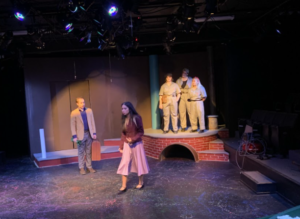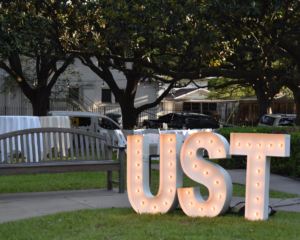As tensions rise and students begin postulating as to what is next, I would like to take a moment to give my thoughts on the restructure and this last meeting.
Last Tuesday, [UST President] Dr. Ludwick attended our Senate meeting. My thoughts are that it was a very successful meeting, and very productive. In some ways, we are still at the same place as when we held the public forum, and in others we are more informed.
This is what we know so far: The administration-led restructure was initiated by Dr. Ludwick in response to the University’s crippling debt, a staggering figure of around $8.5 million by this year. In order to tackle this debt, Dr. Ludwick introduced the five-year plan, “The call towards tomorrow,” which is an effort to turn the university around. Ultimately, the goal is to not only return the university to a tenable state, but to raise it higher than it has been.
In order to do so, there are a few things that he says needs to happen. He started with the university and its need to re-examine its business plan. About 10 years ago, the University had one of the strongest graduate programs in the country, and those programs helped the University meet its bottom line. However, since then, graduate enrollment has declined and undergraduate enrollment has continued to decrease until recently (for the most part), so the old business model of relying on graduate students simply does not work anymore.
To fix this, Dr. Ludwick, in conjunction with Dr. Evans and the Board of Directors, has stipulated some changes, much of which may be seen faculty-side. The grandest of these changes is the removal of the opt-out system. Currently, faculty that are contracted to work for 9-12 hours may sit on a University committee and be excused for some of those hours while still being paid. This has led to a large number of professors working for only six out of their nine hours, and so on.
This, in turn, led to an increase in the number of professors being hired to teach, and most of them working part-time. The proposed change has resulted in several professors being given notice of non-renewal and the subsequent backlash from students has been tremendous. So the question then becomes, what other options do we have to restructure that do not include laying off professors? The answer seems to be, we don’t.
According to Dr. Ludwick, the plan to not recontract certain professors is the result of an exhaustive department analysis and is one that will not budge unless the Board of Directors changes it. The real question is, do the students have input? The short answer? No. The longer answer? No, but with details. Dr. Ludwick made the case that the students were asked “about the restructure” a few years ago, citing surveys that were sent out and discussions with what was, at the time, Student Government Association.
To his credit, he certainly did have discussions with SGA about what sort of programs they wanted to see at the University and what they thought we could do better. The surveys were essentially the same. So his response that we were consulted about the restructure is more of a half-truth, rather than in full. Perhaps through no fault of his own, but a half-truth nonetheless.
But, on the other hand, how exactly do you poll the student body on something like this? Do you say, “We are restructuring and plan on laying off certain professors, what do you think?” Student reaction would invariably be no.
Many students share a very tight bond with their professors, due in part to the small class size and one-on-one interactions, so they never want to see their professors go.
So, what is the solution?
Certainly it isn’t to ask the student body which professors to drop; that is as unprofessional as it is illegal. So, it seems that proceedings are going as they should. No one is happy about them, but they are what they need to be. The issue, then, is with the lead-up to the restructure.
So, let’s talk about transparency.
Students largely feel as though their voice is not being heard because they did not know these things would happen. All we knew was that the restructure would happen and that things would change. We did not know that we would lose our favorite professors and so on.
So, moving forward, what I would like to see is transparency. Would the administration be willing to outline the plan proposed Dec. 5th at the Board of Directors meeting to the students in a manner that reaches as many people as possible, and is as clear as possible?
What we want to hear is not that we are receiving a new residence hall, or a new sports team. While those things are great, we need to hear both the good and the bad so we can prepare for it and, just maybe, find a way to avoid what would otherwise seem unavoidable.
This just leaves the future. Many students choose UST because it is affordable. And the administration should be lauded for making it as accessible as it is. For a majority of the population, scholarships and grants, as well as the new flat-rate tuition, have made something that may have been previously inaccessible affordable. I know it has been for me. When I looked at the cost of tuition, I didn’t think there was any way that I would be able to afford it, but through scholarships and grant programs, and by being able to give back to this university as a Resident Assistant and the Vice-President of the Senate, I have been able to afford this school; and I know I’m just one of many that share this experience. But it can’t last forever.
We have a finite amount of resources, and a finite amount of donors. The administration hopes to offset this by creating alumni that love this University and will help it grow, but my cynical self simply can’t see us having enough high-donating alumni by 2025, when we are supposed to have 8,000 students.
Ultimately, the cost of tuition may not rise significantly, but the paid cost of tuition might. And there’s the rub. We have a wonderful experience at UST, and one that I would love to share with people. I simply worry that our rate of expansion may leave out some of those that the administration would like to take in: To quote Dr. Ludwick, “The gritty students. The ones for whom this University is their parent’s hope; the first-generation students.” Clearly we will see more support as we increase our presence both locally and nationally, but the question still remains: is it sustainable, and will we truly have a say in it? I certainly hope so, but it will take time to find out.
Jack Dowling
Chair of Senate 2019-2020





Be First to Comment